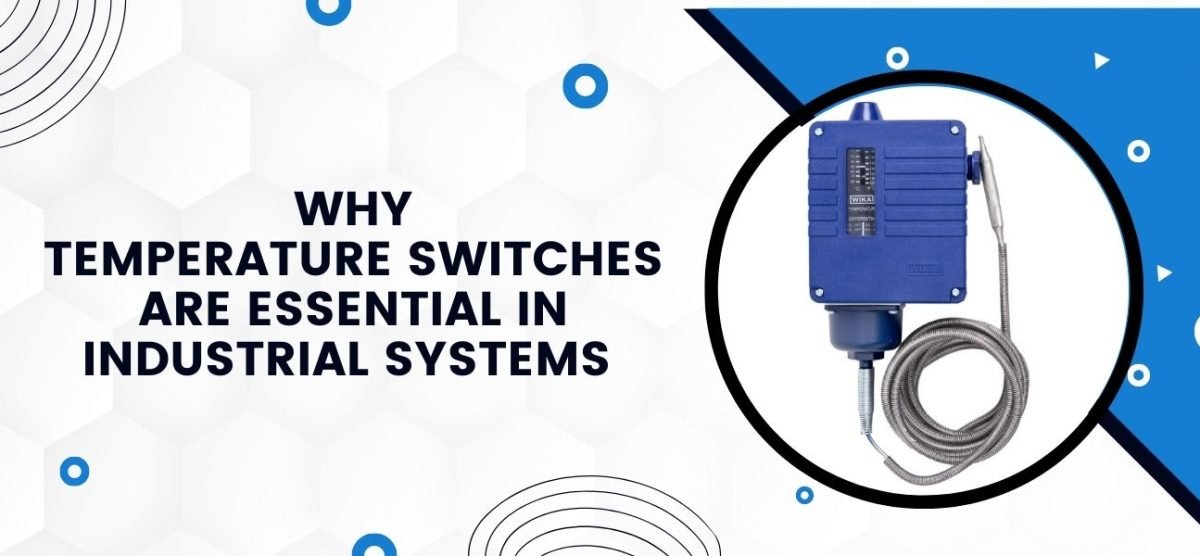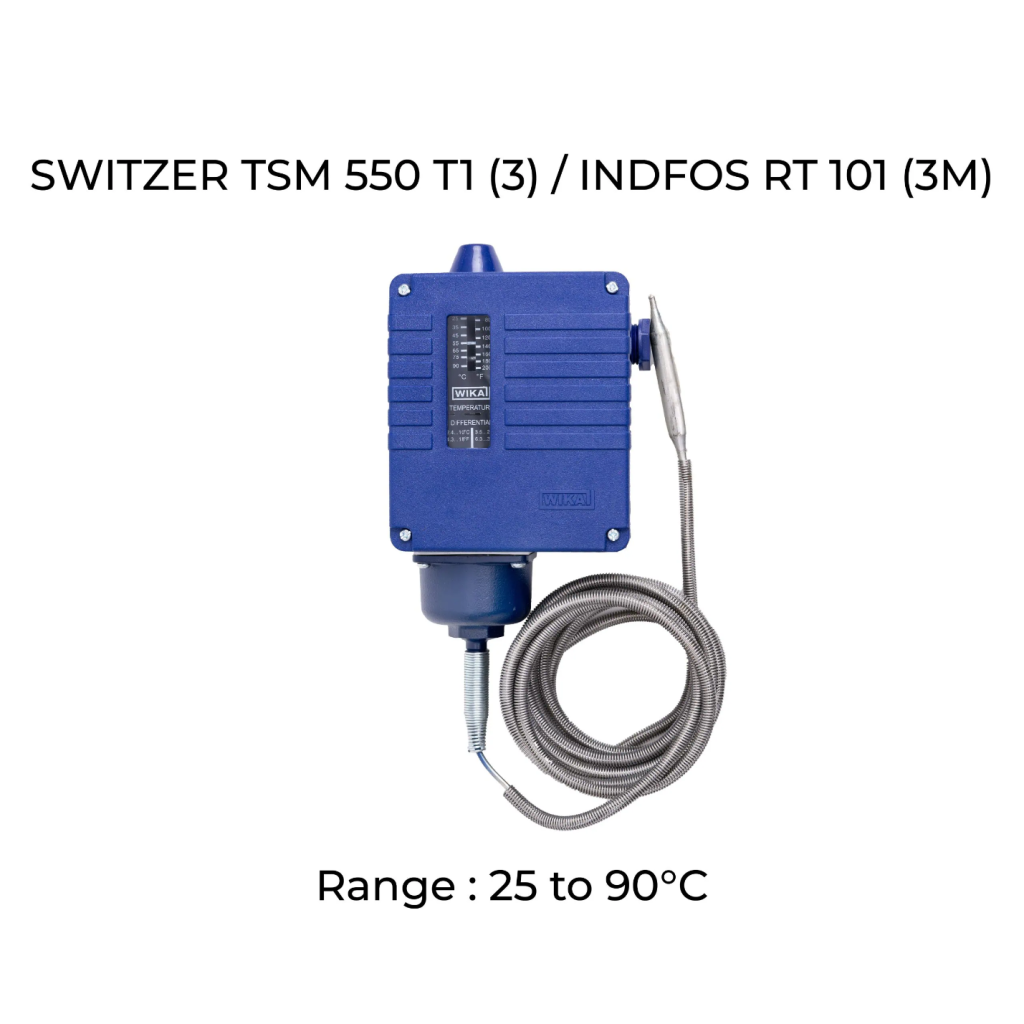Why Temperature Switches are Essential in Industrial Systems

In every electrical and electronic application, switches play a crucial role in controlling devices, making them essential components of any control system. In industrial settings, various types of switches are employed for specific functions, including toggle, slide, push button, rotary, liquid level, temperature, pressure, and more. Among these, temperature switches are particularly prevalent in industries for monitoring and regulating machinery temperatures. This article focuses on temperature switches, detailing their operation and applications. We will explore how temperature switches work, the different types available, and their various uses, with a special emphasis on SWITZER/INDFOS Temperature Switches.
What Are Temperature Switches?
Temperature switches are devices designed to monitor and control temperature levels within a system. They work by activating or deactivating a circuit when a specified temperature threshold is reached. This functionality helps maintain system stability, prevent overheating, and ensure efficient operation.

Working Principle of SWITZER/INDFOS Temperature Switches
The primary function of a temperature switch is to detect changes in temperature and trigger a response when these changes exceed preset limits. Here’s a basic overview of how temperature switches operate:
- Temperature Sensing: Temperature switches use various sensing elements, such as bimetallic strips, thermocouples, or resistance temperature detectors (RTDs), to detect temperature changes. These sensors convert temperature variations into mechanical or electrical signals.
- Setpoint Adjustment: The switch is configured to activate or deactivate at a specific temperature setpoint. This setpoint can often be adjusted based on the requirements of the application.
- Activation Mechanism: Once the temperature reaches the setpoint, the switch’s mechanism—whether mechanical or electronic—responds. For mechanical switches, this might involve a physical movement that opens or closes a circuit. For electronic switches, this typically involves a signal that controls a relay or other switching device.
- Feedback and Control: Temperature switches provide feedback to the system, allowing it to take corrective actions, such as turning on a cooling fan or shutting down equipment to prevent damage.

Types of Temperature Switches
There are several types of temperature switches, each suited to different applications and environments. Here are the most common types:
1.Bimetallic Temperature Switches:
- Description: These switches use two different metals bonded together that expand and contract at different rates. As temperature changes, the bimetallic strip bends and activates a switch mechanism.
- Applications: Ideal for appliances, HVAC systems, and automotive applications where simple and cost-effective temperature control is required.

2. Capillary Tube Temperature Switches:
- Description: These switches use a capillary tube filled with a fluid that expands or contracts with temperature changes. This movement activates the switch mechanism.
- Applications: Common in refrigeration systems, industrial processes, and heating systems.

3. Electronic Temperature Switches:
- Description: Electronic switches use sensors such as thermocouples or RTDs and electronic circuits to detect and control temperature.
- Applications: Suitable for applications requiring precise temperature control and monitoring, such as in medical equipment, data centers, and sophisticated manufacturing processes.

Figure 1Incorrcet pic
- Digital Temperature Switches:
- Description: These switches have a dial or gauge that allows users to manually set the desired temperature threshold. They use mechanical or electronic means to activate the switch when the setpoint is reached.
- Applications: Often used in laboratory settings, HVAC systems, and various industrial applications.
- Digital Temperature Switches:
- Description: Digital switches provide a digital readout of the temperature and often feature programmable setpoints and alarm functions.
- Applications: Common in high-tech applications where precise digital control and monitoring are required, such as in data centers and automated systems.

SWITZER Temperature Switches
Among the various options available in the market, SWITZER Temperature Switches stand out for their reliability, precision, and advanced features. SWITZER is known for manufacturing high-quality temperature switches that cater to a wide range of industrial and commercial applications.
Key Features of SWITZER/INDFOS Temperature Switches:
- Precision Control: SWITZER/INDFOS Temperature Switches offer accurate temperature measurement and control, ensuring that systems operate within optimal temperature ranges.
- Durability: Designed to withstand harsh environmental conditions, SWITZER/INDFOS switches are built to be robust and long-lasting, making them ideal for industrial applications.
- Versatility: SWITZER/INDFOS offers a range of temperature switches suitable for different applications, including HVAC systems, automotive, refrigeration, and more.
- Ease of Use: With user-friendly interfaces and easy installation, SWITZER/INDFOS Temperature Switches are designed for convenience and efficiency.
- Advanced Technology: SWITZER/INDFOS integrates advanced technology in their temperature switches, including digital displays, programmable setpoints, and alarm functions for enhanced control and monitoring.

Applications of Temperature Switches
SWITZER/INDFOS Temperature switches find applications across various industries due to their ability to maintain temperature control and prevent system failures. Some notable applications include:
- HVAC Systems:
Function: Temperature switches are used to regulate heating, ventilation, and air conditioning systems, ensuring they operate efficiently and maintain desired indoor climates.
- Automotive Industry:
Function: In vehicles, temperature switches control engine cooling systems, preventing overheating and ensuring optimal engine performance.
- Refrigeration and Cooling:
Function: Temperature switches in refrigeration systems help maintain proper temperature levels to preserve food and other perishable items.
- Industrial Processes:
Function: In industrial settings, temperature switches monitor and control processes that require precise temperature regulation, such as manufacturing and chemical processing.
- Medical Equipment:
Function: Temperature switches are used in medical devices to ensure they operate within safe temperature ranges, such as in incubators or diagnostic equipment.
- Data Centers:
Function: In data centers, temperature switches help manage cooling systems to prevent overheating of sensitive electronic equipment.
BuyPneumatics: Your Trusted Partner for SWITZER Temperature Switches
BuyPneumatics is a trusted reseller of SWITZER/INDFOS products, ensuring that customers receive authentic, high-quality temperature switches directly from the manufacturer. By partnering with SWITZER/INDFOS, BuyPneumatics guarantees the reliability and precision of every temperature switch they offer. Whether you need a temperature switch for industrial, commercial, or specialized applications, BuyPneumatics provides a comprehensive range of SWITZER/INDFOS temperature switches to meet your specific needs. With BuyPneumatics, you can confidently select the ideal temperature switch, knowing it comes with the quality assurance of SWITZER/INDFOS.
Conclusion
Temperature switches play a critical role in ensuring the safe and efficient operation of various systems and processes. By detecting and responding to temperature changes, these switches help maintain optimal conditions, prevent damage, and enhance overall system performance.
SWITZER/INDFOS Temperature Switches, with their precision, durability, and advanced features, represent a top choice for many industrial and commercial applications. Whether you need reliable temperature control for HVAC systems, automotive applications, or industrial processes, SWITZER/INDFOS provides high-quality solutions designed to meet your needs. Understanding the working principles, types, and applications of temperature switches can help you select the right solution for your specific requirements, ensuring reliable and efficient operation.


